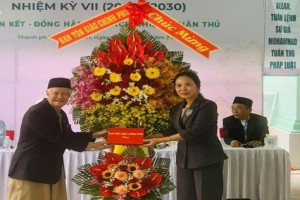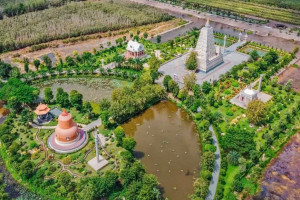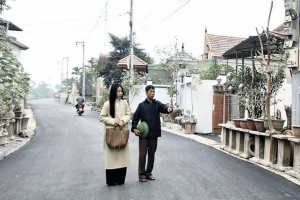
Minh Sư faith, or Way of the Enlightened, has its origin in China. Minh Su faith was bought into Vietnam in late 19th century during the reign of King Tu Duc (1848-1883) by its 15th Patriarch Dong So (1935-1879). Patriarch Dong So established first worshipping places of Minh Su religion (called Buddhist Temple), in old Ha Tien province and Cho Lon city, renamed as Kien Giang province and Ho Chi Minh city nowadays.
In its early state of development in Vietnam, Minh Su faith has created four other practicing branches operating independently, namely: Minh Lý (Enlightened Reasonning), Minh Đường (Enlightened Path), Minh Thiện (Enlightened Kindness) and Minh Tân (Enlightened Innovation). Together with Minh Su faith, these groups formed “Ngu Chi Minh Dao” (Group of five branches of the Way of the Enlightened) - a religious movement appeared in southern Vietnam in the 19th and 20th centuries. Although divided into different and independent branches, but religious principles and worshipping rituals, scriptures, religious hierarchy of Ming Duong, Ming Thien, Minh Ly, Minh Tan are more like the Minh Su.
In a later stage, Minh Su faith further developed into three schools, called Duc Te (Moral Salvation), Pho Te (Universal Salvation) and Hoang Te (Propagating Salvation). These three schools were consolidated into a church with the full name as “Minh Su Theravada Buddhist Church” (Giao hoi Phat duong Nam tong Minh su Dao), or Minh Su religion for short.
In 1920 Minh Su religion completed an administrative system from the central to grassroots level, with tens of thousands of followers and more than 50 worshipping places in many Southern provinces and cities of Vietnam.
From 1975 onwards, followers of Minh Su church continued maintaining religious practices at home and the church’s established temples. Under the Ordinance on Belief and Religion 2004, Minh Su religion was officially recognized by the State of Vietnam in October 2008.
Currently Minh Sư religion has 51 worshiping temples and about 13,000 followers in around 20 provinces and cities concentrating in Southern Vietnam, including Ho Chi Minh city, Hanoi, Ba Ria-Vung Tau, Tien Giang, Hau Giang, Can Tho, Lam Đong, Khanh Hoa, Phu Yen, Binh Đinh, Ninh Binh, Quang Nam, Ben Tre, Kien Giang, Đa Nang, Đong Thap, Vinh Long, Long An,... The head office of Minh Su faith is currently located at Quang Nam Buddhist temple in Tran Quang Khai Street, Ho Chi Minh City.
Regarding religious characteristics, Minh Su faith worships the Supreme Creator and Founders of Buddhism, Taoism and Confucianism. Minh Su religion as well combines basic elements of above three major Eastern religions. However, Minh Su faith has also developed its own set of religious scriptures with teachings ranging from worldview, religious tenets, and fundamental practicing principles to cannon laws.
Fundamental principles of Minh Su faith stress the importance of self-cultivation and self-practice for salvation and spiritual enlightenment. The religion’s combination of essential teachings of Buddhism, Taoism and Confucianism aims to retrace these three religions from the one and the same original source, which practically contributes to promotion of religious unity in a country strongly influenced by these three great Oriental religions.
In the religious practicing system, Minh Su faith has 13 practicing rankings, from the Patriarch on the top level down to those registered to support the religion at the lowest level, and these rankings are grouped into three categories: Superior, Middle and Interior. In accordance with the religious laws, new converts to Minh Su religion, which belong to the second lowest ranking, have to strictly keep first five Buddhist precepts, be purely vegetarian and practice celibacy, and the higher in practicing rankings, the more precepts to be observed.
In worshipping establishments of Minh Su religion, worshipping rituals are maintained daily, particularly at 6am, 11am, 6pm and 11pm. Religious ceremonies are regularly conducted on the two days of new moon and full moon every month. Other important festivals of Minh Su religion include ceremonies on the Ninth, Tenth and Fifteenth of the first lunar month; the Nineteenth of the second lunar month; the Eighth and the 29th of the fourth lunar month,… In religious ceremonies and rituals, dignitaries and followers of Minh Su faith wear long black dresses and white trousers.
Minh Su faith set up two levels of religious administration. The local level consists of management boards of religious worshipping establishments in provinces and cities; the management board of each religious establishment consists of from 3-5 members, with the serving term of three years. The central level stands the Council of Religious Elders and the Central Executive Committee. The Council of Religious Elders is a supreme body of the religion and consists of ten most prestigious members nominated by followers; once nominated, these religious elders would serve till the end of their life. The Central Executive Committee has from 15-19 members and a serving term of five years long.
Followers of Minh Su faith are very active in social activities, especially charities. Each worshipping establishment of Minh Su faith set up a medicinal charity to offer medicines and medical treatments to poor patients.
Throughout its development history, Minh Su faith has peacefully coexisted with other beliefs and religions in Vietnam, and contributed to promote religious harmony and enrich the religious diversity in Vietnam./.




